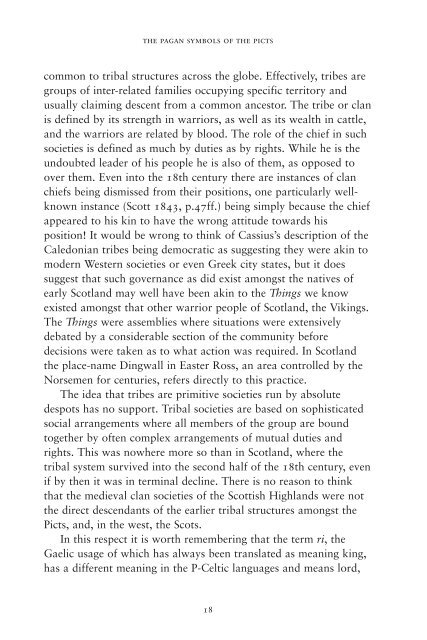Pagan Symbols of the Picts by Stuart McHardy sampler
Stuart McHardy examines the Pictish symbols which have been discovered on various items across Scotland. The book sets out a cohesive interpretation of the Pictish past, using a variety of both temporal and geographical sources. This interpretation serves as a backdrop for his analysis of the symbols themselves, providing a context for his suggestion that there was an underlying series of ideas and beliefs behind the creation of the symbols.
Stuart McHardy examines the Pictish symbols which have been discovered on various items across Scotland. The book sets out a cohesive interpretation of the Pictish past, using a variety of both temporal and geographical sources. This interpretation serves as a backdrop for his analysis of the symbols themselves, providing a context for his suggestion that there was an underlying series of ideas and beliefs behind the creation of the symbols.
You also want an ePaper? Increase the reach of your titles
YUMPU automatically turns print PDFs into web optimized ePapers that Google loves.
<strong>the</strong> pagan symbols <strong>of</strong> <strong>the</strong> picts<br />
common to tribal structures across <strong>the</strong> globe. Effectively, tribes are<br />
groups <strong>of</strong> inter-related families occupying specific territory and<br />
usually claiming descent from a common ancestor. The tribe or clan<br />
is defined <strong>by</strong> its strength in warriors, as well as its wealth in cattle,<br />
and <strong>the</strong> warriors are related <strong>by</strong> blood. The role <strong>of</strong> <strong>the</strong> chief in such<br />
societies is defined as much <strong>by</strong> duties as <strong>by</strong> rights. While he is <strong>the</strong><br />
undoubted leader <strong>of</strong> his people he is also <strong>of</strong> <strong>the</strong>m, as opposed to<br />
over <strong>the</strong>m. Even into <strong>the</strong> 18th century <strong>the</strong>re are instances <strong>of</strong> clan<br />
chiefs being dismissed from <strong>the</strong>ir positions, one particularly wellknown<br />
instance (Scott 1843, p.47ff.) being simply because <strong>the</strong> chief<br />
appeared to his kin to have <strong>the</strong> wrong attitude towards his<br />
position! It would be wrong to think <strong>of</strong> Cassius’s description <strong>of</strong> <strong>the</strong><br />
Caledonian tribes being democratic as suggesting <strong>the</strong>y were akin to<br />
modern Western societies or even Greek city states, but it does<br />
suggest that such governance as did exist amongst <strong>the</strong> natives <strong>of</strong><br />
early Scotland may well have been akin to <strong>the</strong> Things we know<br />
existed amongst that o<strong>the</strong>r warrior people <strong>of</strong> Scotland, <strong>the</strong> Vikings.<br />
The Things were assemblies where situations were exten si ve ly<br />
debated <strong>by</strong> a considerable section <strong>of</strong> <strong>the</strong> community before<br />
decisions were taken as to what action was required. In Scotland<br />
<strong>the</strong> place-name Dingwall in Easter Ross, an area controlled <strong>by</strong> <strong>the</strong><br />
Norsemen for centuries, refers directly to this practice.<br />
The idea that tribes are primitive societies run <strong>by</strong> absolute<br />
despots has no support. Tribal societies are based on sophisticated<br />
social arrangements where all members <strong>of</strong> <strong>the</strong> group are bound<br />
toge<strong>the</strong>r <strong>by</strong> <strong>of</strong>ten complex arrangements <strong>of</strong> mutual duties and<br />
rights. This was nowhere more so than in Scotland, where <strong>the</strong><br />
tribal system survived into <strong>the</strong> second half <strong>of</strong> <strong>the</strong> 18th century, even<br />
if <strong>by</strong> <strong>the</strong>n it was in terminal decline. There is no reason to think<br />
that <strong>the</strong> medieval clan societies <strong>of</strong> <strong>the</strong> Scottish Highlands were not<br />
<strong>the</strong> direct descendants <strong>of</strong> <strong>the</strong> earlier tribal structures amongst <strong>the</strong><br />
<strong>Picts</strong>, and, in <strong>the</strong> west, <strong>the</strong> Scots.<br />
In this respect it is worth remem b e ring that <strong>the</strong> term ri, <strong>the</strong><br />
Gaelic usage <strong>of</strong> which has always been trans lated as meaning king,<br />
has a different meaning in <strong>the</strong> P-Celtic languages and means lord,<br />
18


















